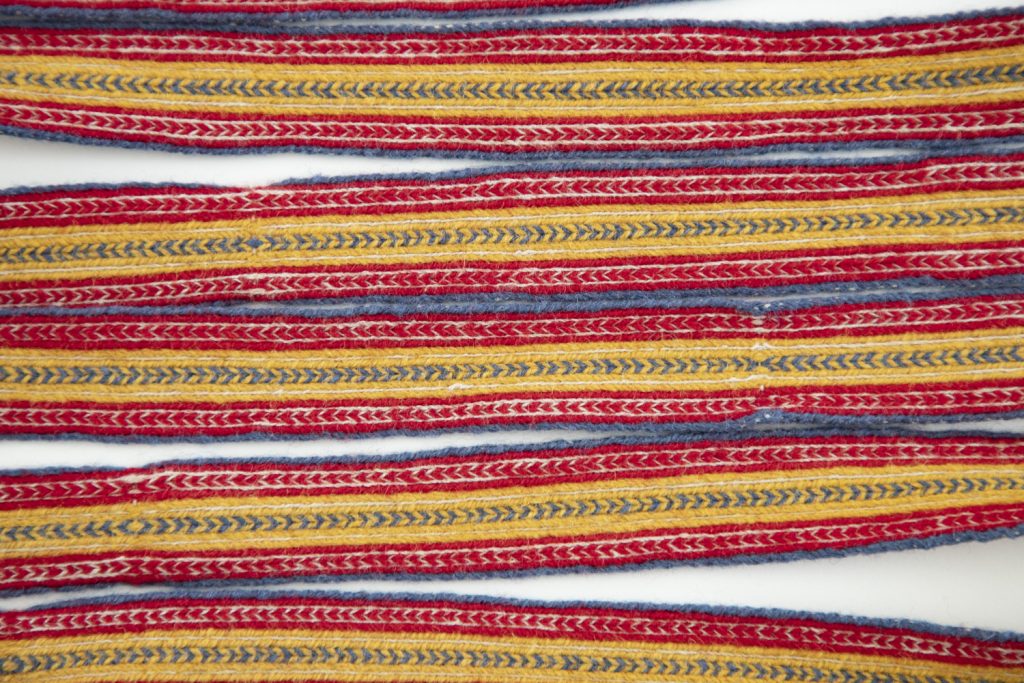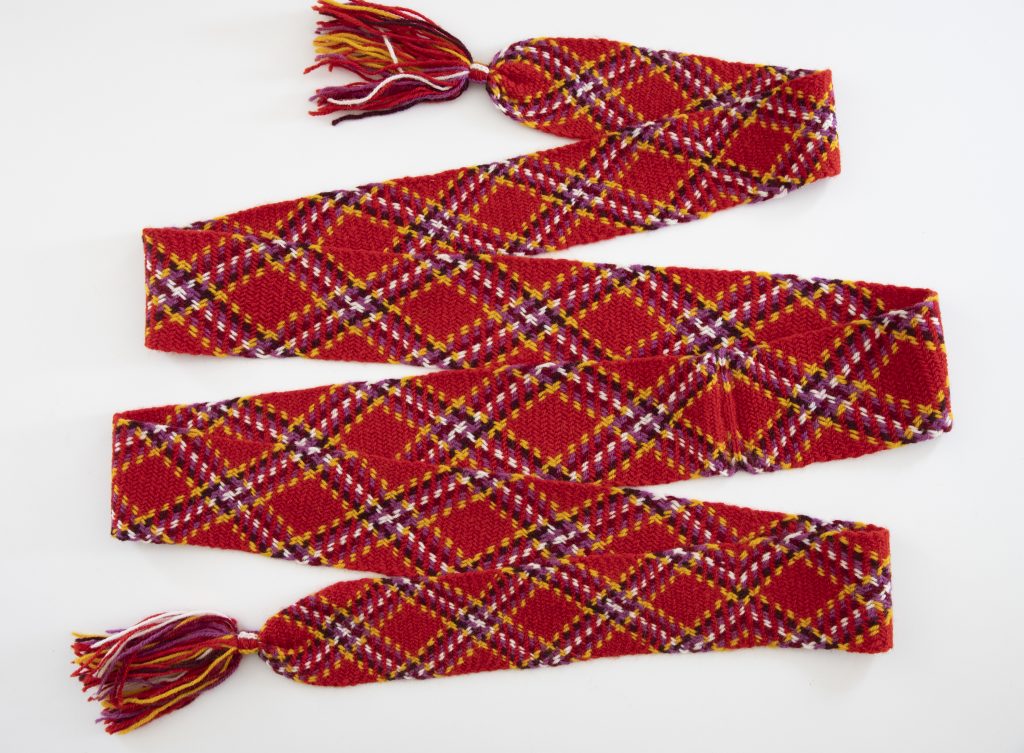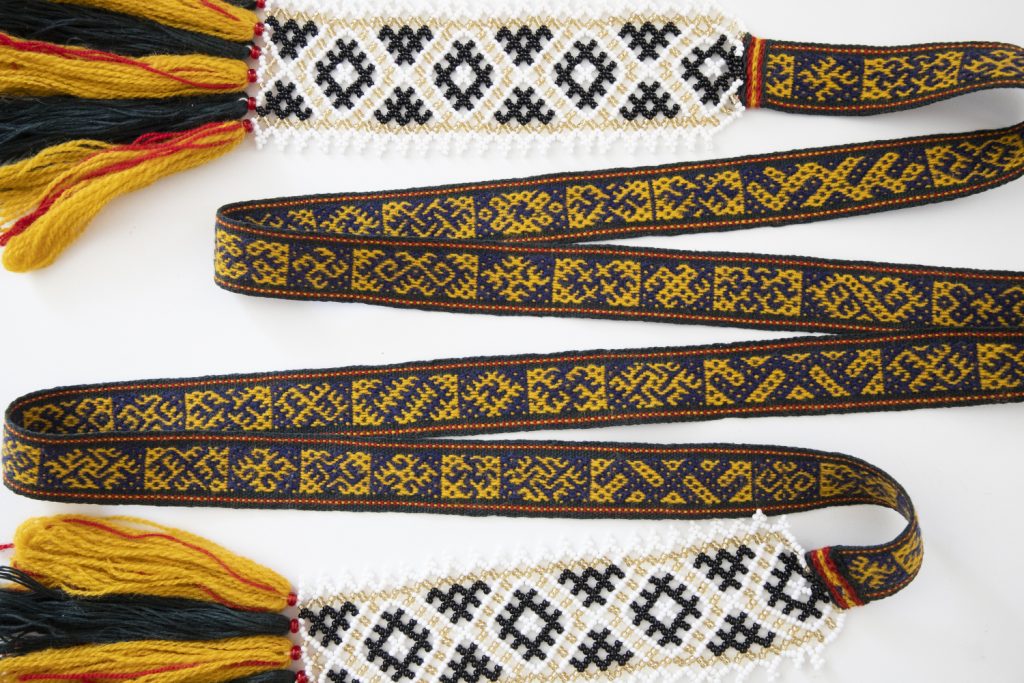Author:
Edīte Kuzmane, Anete Karlsone
Traditional craft skills
Title
Making Traditional Latvian Belts and Belt Textiles (2024)
Narrow or belt-type textiles are long and narrow, with a width ranging from approximately 0.5 cm to 15 cm, usually up to 8 cm.
Belt textiles can be classified by:
• by manufacturing technique and composition;
• by use;
• by local types or region of distribution.
Classification of belt textiles according to manufacturing technique and composition (in order of development):
• celaines (striped, needle-pointed, patterned);
• pītenes;
• aulejas;
• audenes (striped, floral, patterned).
The community of traditional belt weavers consists of people who weave without using a loom. They have learned these skills from a master weaver, within their family, from written sources, or from video materials. This method of production enables people of all ages and backgrounds to learn the skills, as it uses simple, everyday tools such as sticks, cardboard, thread and string.
The community's core consists of the masters, Lilija Balgalve-Treimane and Edīte Kuzmane, who have mastered traditional belt textile weaving skills and pass them on to other enthusiasts. This is possible both directly, through masterclasses, individual or group lessons, and indirectly, through studying written records and video materials.
The community is based on the scientific and methodological work of Anete Karlsone and Sanita Kozuliņa, who research, describe and publish descriptions of historical materials, as well as prepare methodological literature.
The community is growing by engaging with members of the public interested in Latvian traditional culture, who wish to learn traditional craft skills, create and wear folk costumes, and celebrate traditional annual and family holidays. Some community members also incorporate traditional belt textiles into modern clothing.
The Lielvārde Belt Weavers' Group brings together people from all over Latvia. Some attend the monthly meetings regularly, while others only participate when topics of interest to them are scheduled. Since 2016, more than 50 weavers have learnt the traditional belt-making technique. Some continue to weave belts only for their own use, while others share their experience at various venues, including the Savieši community in Ķekava, the Rota applied arts studio, the Krustaines handicraft studio in Saulkrasti, the Baltaine association in Koknese, the Krustpils applied arts studio, the Kodaļa weavers’ group in Saulkrasti and the Saulesraksti belt weavers’ group in Engure.
The open nature of the group’s activities has enabled its members to acquire skills in Lielvārde and take them back to their places of residence and work. When preparing the application, we conducted a survey to identify traditional belt weavers. (The results of the survey and a list of master belt weavers are available on the community’s website: www.balticbelt.com)
Significance in community life
Weaving traditional belts with simple tools provides an opportunity to practise traditional craft skills at a time and place of one’s choosing, without being tied to a specific workshop. At the same time, it allows an unlimited number of weavers to come together in a shared activity. Traditional belt weaving uses a variety of technical solutions that enable weavers to create a wide range of items, including accurate replicas of ancient objects and new works within the framework of tradition. For community members, traditional belt weaving is a form of self-education and self-expression, as well as a means of socialisation and connection with traditional cultural heritage, helping to cultivate Latvian identity.
Activities
Traditional belt weaving begins with preparing the warp and weft materials (yarn and thread). To obtain a high-quality product, twisted yarn is needed for the warp; if this is unavailable, it must be prepared by the weaver. Once the weaving technique is understood, the necessary tools are selected, adapted or made. Sticks are used for braiding, warp for coiling and strings for tying and stretching the warp. Braiding for belts is usually done by securing the warp at one end. For entangled braiding, the warp can be secured at both ends. To weave celaines, square boards made of wood, cardboard or other materials with a hole in each corner for threading are required. These boards are best made to a size suitable for the weaver’s hand (on average 5–7 cm). To weave audenes, the weaver needs a bobbin or roller to wind the warp thread, a stick to tie the healds and string to tie and stretch the warp. For narrow fabrics, a special wooden frame can be used instead of the bobbin and healds. Weaving is done by firmly securing one end of the warp braid to a belt tied around the weaver’s waist, with the other end left free for weaving. The weaver uses their body strength to ensure the necessary tension in the warp. Tools used in the weaving process include a weaving knife, shuttle and weaver’s belt, as well as other auxiliary tools. There are many different colour and pattern variations in each belt technique. These can be found in books and publications on belt weaving, as well as in countless videos. (See the list of the most important publications below!)
Beliefs, rituals, and unwritten rules
Prerequisite: weave in a good mood because when you are angry, the threads 'don't obey'; they twist and break. Each weaver can develop their own habits to follow during the belt weaving process. For example, some weavers start weaving during the new moon phase so that the work goes quickly.
Passing on and transferring skills
Weaving techniques are best learned directly from a master, or remotely with the help of a video in exceptional cases. Written sources can also be used for this purpose. To learn traditional techniques, it is important to familiarise yourself with the collection of belt type textiles kept in museums, as these provide direct information on all aspects of product quality. Since 2012, craftsmen from Lielvārde and, since 2016, the Lielvārde Belt Weavers' Group led by Edīte Kuzmane, have participated in the “Satiec savu meistaru!” event. (Meet Your Master Craftsman!), in which participants can learn how to make belts without a loom, a traditional belt-making technique. The Folk Costume Centre Josta has been established in Lielvārde, where the belt weavers' community meets, and where individual consultations and training sessions are held to introduce interested parties to traditional belt weaving. The number of community members varies, as it includes both craftsmen and enthusiasts who wish to acquire the knowledge and skills to create a unique belt for themselves or their families.
In the 2018/19 academic year, Edīte Kuzmane created an interest-based education programme called Latvian Traditional Belt Weaving. Other community members also pass on traditional belt weaving skills:
• Lilija Balgalve-Treimane is a master of traditional belt weaving. While living in exile in Canada, she played an active role in preserving and passing on this skill, giving masterclasses at 2x2 Latvian camps in America and Australia, as well as at 3x3 Latvian camps in Latvia. After returning to Latvia, she continued her work on methodological materials for belt making and published a book called Celaines. Celu jostu un apaudu aušana (2018). Ms Balgalve-Treimane also gives masterclasses at the Lielvārde Crafts Centre, the Dobele Crafts House, the Kamene Folk Applied Arts Studio and to other groups;
• Traditional culture researcher Anete Karlsone has published several articles on Latvian belt types, as well as a book entitled Rakstainās jostas: kopīgais kultūrslānis (Patterned Sashes: A Shared Cultural Layer) (2014). She also gives lectures and masterclasses on traditional belt weaving and yarn preparation, including dyeing with plant dyes;
• Belt-making master and belt collection researcher Sanita Kozuliņa has compiled material on woven and Lielvārde-type belts, and provides theoretical and practical lessons in the traditional textile production of belts.
History
The oldest belt textile finds in Latvia date back to the 6th century (Ģinters 1936: 16), and a diverse tradition of belt-making developed between the 9th and 13th centuries (Zariņa 1970, 1988). Evidence of belt textiles as clothing components has also been preserved from later centuries (Žeiere, 2008). A wide variety of such textiles can be seen in Latvian ethnographic material, available in the form of numerous objects, drawings, photographs and written records in Latvian museum collections.
The simple tools required for making traditional belts suggest that this skill dates back to the origins of weaving. They also indirectly testify to the existence and transmission of this skill within families, households and communities. At the same time, this traditional method of belt weaving also existed as a craft industry (Lauva 1894; Niedre 1930). The production of more complex belts became a source of income for skilled craftswomen, but the tools remained easily accessible and simple to make — the skill of the belt maker was the decisive factor. Consequently, a magnificent collection of traditional Latvian belts has been preserved in museum and private collections.
Interest in traditional handicraft techniques, including belt-making, grew in Latvian society with the establishment of the nation state, after having been partially forgotten. A significant contribution to this field was made by Eduards and Alma Paegle (Birgel-Paegle 1925; Paegle 1925; Paegle 1929). Traditional belt weaving became a popular form of Latvian handicraft and was included in the school handicraft programme. During the Soviet occupation, Ilga Madre, an ethnographer, handicraftswoman and head of the applied arts studio, popularised traditional belt weaving (Ivanova and Madre, 1968). Overall, however, belt weaving on belt looms or weaving frames (wide fabric looms) became more prevalent during this period. The traditional method of belt making using specialised tools continued to be practised by individual craftspeople.
Following Latvia's restoration of independence, traditional belt weavers such as Māris Maniņš, Inese Krūmiņa and others gained greater public recognition. Lilija Baltgalve-Treimane has also made a significant contribution to the field.
Some belt weaving techniques can also be used on flat looms, which are the main type used today. However, changing the technological process also affects the quality of the belts – weaving on looms does not allow the fabric structure to be made dense enough or the product to be made fine enough. Traditional Latvian belts are still in active use and are being made and worn, but mostly using simplified techniques, such as weaving on looms, which are not always accessible to a wide range of craftspeople. The skill of making belts without looms is disappearing as insufficient information is available to the public about the highest quality of belt that can be achieved using simple weaving tools. Using these tools makes this traditional craft accessible to many craftspeople. We consider it important to protect and preserve this ancient skill for future generations.
Additional Information
DYEING YARN WITH PLANT DYES
The use of colourful yarns dyed with plant dyes can clearly be seen in the oldest belt textiles. This is also an important factor when reproducing objects as accurately as possible. Using naturally dyed yarn in modern versions of belt textiles is interesting and accessible.
THE TRADITION OF WEARING FOLK COSTUMES. THE LATVIAN WAY OF LIFE
Many preserved belt textiles are an integral part of folk costumes and are available for study and reproduction. These costumes, as well as individual belts used in activities related to the rhythms of time and life, help us to better understand the identity of the people and ensure the relevance of their creations today.
Masters
• Master Lilija Balgalve-Treimane, master of traditional belt weaving; teacher; author;
• Belt weaver and researcher, Dr hist. Anete Karlsone, a leading researcher at the Institute of Latvian History at the University of Latvia, and an author;
• Edīte Kuzmane is the founder of the Lielvārde Belt Weavers' Group and the chair of the board of the Lielvārde Belt Weavers' Foundation.
Masters who make belt textiles in the traditional way are highly valued in Latvia and around the world. Those mentioned here can be found in the Lielvārde Belt Weavers' Group and elsewhere in Latvia. These skills are also passed on through online courses.
Information about other masters who have agreed to cooperate as traditional belt makers and pass on their skills to others is available in the appendix.
This list will be updated and made available to the Lielvārde Belt Weavers' Association.
Agencies and institutions
• Lielvārde Belt Weavers’ Foundation;
• National and regional museums – belt collection keepers;
• Craft centres and groups such as the Savieši community in Ķekava, the Rota applied arts studio, the Krustaines handicraft studio in Saulkrasti, the Baltaine association in Koknese, the applied arts studio in Krustpils, the Kodaļa weavers' group in Saulkrasti and the Sauleskrasti belt weavers' group in Engure.
Consolidation
Participation in the event organised by the Latvian National Centre for Culture, 'Meet Your Master Craftsman!'. – Individual and group lessons to learn skills. The belt-making programme has been an extracurricular activity at Lielvārde Edgars Kauliņš Secondary School since 2018 and at Ogre Secondary School No. 1 since 2022. The Lielvārde Belt Weavers' Group has been operating since 2016.
Promoting public awareness of the diversity and richness of traditional Latvian belt-making increases demand for these belts and encourages their production. Every year, the “Meet Your Master Craftsman!” event draws attention to this traditional skill through publicity activities. Many participants in the Lielvārde Belt Weavers' Association's activities continue to learn belt weaving by joining the group, attending individual courses, searching for materials in museums and learning independently through practice. Children have had the opportunity to learn about intangible cultural heritage and successfully apply the skills they have acquired to modern life by creating small items using traditional belt-making techniques, which delights them, their friends, and their families.
Funding from the State Culture Capital Foundation has been received to prepare the visual aspect of the application. We have also received the opportunity to use materials from the Edgars Kauliņš Lielvārde Museum in Ogre Municipality. Support is planned from the Latvian Ministry of Culture, the State Culture Capital Foundation, the Ogre District Municipality and the municipalities involved in the projects, e.g. the “Aužam dabā” (Let's Weave in Nature) project, as well as other institutions involved in implementing the planned activities. Support has already been received from the Zied Zeme Public and Private Partnership Association for participation in the “Colabora Lielvārde” project in the co-working space, and from the State Culture Capital Foundation for preparing the application. Planned cooperation includes state and local government cultural institutions, the Ogre Municipality, the Rural Support Service and thematically related non-governmental and professional organisations.
Continuation/development
During the period from 2025 to 2030, the foundation “Lielvārdes Jostu audēji” (Lielvārde Belt Weavers), in cooperation with state, local government and non-governmental institutions, plans to:
• Begin identifying and documenting traditionally made belts from private collections and lesser-known museums in regions where a belt weavers' community has been established;
• Continue exploring the collections of belt textiles at the Latvian National History Museum, the Latvian Open-Air Ethnographic Museum, and regional museums;
• Begin establishing a permanent workshop as a museum, educational, research and consultation centre;
• Organise an educational seminar entitled 'Belts around the Baltic Sea', inviting specialists, practitioners and theorists from different countries to present their work on researching, preserving and transmitting traditional belt weaving skills;
• Produce publications that promote traditional belt weaving.
During the period from 2025 to 2030, the foundation “Lielvārdes Jostu audēji” (Lielvārde Belt Weavers), in cooperation with state, local government and non-governmental institutions, plans to:
1. Practice and self-education:
1.1. Regularly organise exhibitions of belt textiles and participate in folk applied art exhibitions offered by the Latvian National Culture Centre;
1.2. Improve the range of activities offered by the 'Meet Your Master Craftsman!' event by inviting lecturers and craftspeople to participate;
1.3. Invite lecturers to educate and broaden the horizons of members of the Lielvārde Belt group and other interested parties.
2. Training:
2.1. Develop a procedure for obtaining a certificate to prove that a belt weaver (community member) has acquired the necessary knowledge, skills and ability to work within the framework of the tradition. This certificate will entitle the weaver to work as a master practitioner of traditional skills and pass on this tradition to others;
2.2. Develop an offer for schools within the framework of the 'Skolas soma' (School Bag) programme;
2.3 Organise belt weaving camps for children in the summer. Organise summer belt weaving camps for children;
2.4. Implement a series of high-quality classes, including workshops and masterclasses on traditional belt weaving. These will be held at community members' places of work and at other handicraft groups in Latvia. The aim is to continue improving and passing on skills.
2.5. Begin developing and publishing methodological materials for teaching traditional belt-making to children and adults.
3. Recognition:
3.1. Maintain and update a website on traditional belt weaving;
3.2. Develop a label for traditionally made belt textiles to raise their profile in public spaces. This is an important means of communication between craftsmen and buyers, raising public awareness and discernment in the handicrafts market;
3.3. Create and launch the 'Belt Days at the Museum' project, during which weavers will weave belts for one or more days in the museum's exhibition rooms. This activity is planned to be offered to museums throughout Latvia. The types of belts woven will be adapted to the museum – the Daugavpils Museum will feature Latgale belts, the Kuldīga Museum will feature Alsunga-type belts, and so on. During the event, the weavers will demonstrate and explain the principles of traditional belt weaving. Other public belt weaving events will also be organised;
3.4. Start work on creating a Belt Days Festival in Lielvārde. The programme will include workshops for children and adults, as well as theoretical seminars and other activities. To promote the exchange of experience, the festival will also invite representatives from other countries.
The set of measures is planned with the following objectives:
• To continue researching the nominated element;
• To preserve skills (practice) and knowledge within the community;
• To provide high-quality training and skills transfer;
• To promote public awareness of the element.
Threats
The practice and transmission of traditional belt weaving is under threat due to a lack of information regarding the benefits and characteristics of belt textiles produced using specialised belt-weaving tools. In the commercial handicraft environment, loom-based belt weaving dominates. While this can ensure greater productivity, it significantly reduces the quality of the product. A lack of public education about the high value of traditional belt weaving skills and the added value they create hinders competition in the sale of handicrafts, as buyers lack information about what determines the higher price of traditionally woven belts. There is also a threat posed by insufficient information about the diverse uses of belt textiles today, both as part of traditional costumes and as elements of modern clothing, as well as in other forms.
Applicant
Edīte Kuzmane, Lielvārdes Jostu audēji (Lielvārde Belt Weavers) Foundation, reg. No. 40008324476.
Image Gallery
Video
Text Materials
Publications
Baltgalve–Treimane, Lilija (2018) Celaines: celu jostu un apaudu aušana. Rīga: [Rakstu Pūrs]
Bička, Anete (1990) Vēlreiz… un no jauna par Lielvārdes jostām. Dabas un vēstures kalendārs 1991. gadam. Rīga: Zinātne, 251.–256. lpp.
Bička, Anete (1991) Pārdomas par Lielvārdes jostām. Daugavas raksti. Rīga: Zinātne, 88.–100. lpp.
Birgel–Paegle, Alma (1925) Celi. Latvijas Saule. Nr. 28–30: 17(321). lpp.
Dzērvītis, Aleksandra, Treimanis, Lilija (1982) Latviešu jostas. Kanāda: Toronto Daugavas Vanadzes
Ģinters, Voldemārs (1936) Latviešu tautas tērpa aizvēsture. Ievads latviešu tautas tērpu vēsturē. Rīga: J. Grīnbergs, 6.–92. lpp.
Ivanova, Gundega, Madre, Ilga (1968) Jostu raksti. Rīga: Liesma
Karlsone, Anete (1992) Sens jostu raksta kompozīcijas pamatprincips. Dabas un vēstures kalendārs 1993. gadam. Rīga: Zinātne, 229.–233. lpp.
Karlsone, Anete (1993) “Ieskats latviešu jostu raksta ornamenta izpētes problēmās.” Latvijas Vēstures Institūta Žurnāls, No. 2: pp. 19–31.
Karlsone, Anete (1994) ““Zalktis” latviešu jostu audumos.” Ornaments Latvijā: materiāli mākslas vēsturei. Rīga: Zinātne, pp. 78–84.
Karlsone, Anete (1996) Izzudušo Kurzemes jostu meklējumi. Latvijas Vēstures Institūta Žurnāls, Nr. 3: 58.–72. lpp.
Karlsone, Anete (1996) “Jaunatklātais Kurzemes jostu tipoloģijā. Četri Alsungas rakstaino jostu tipi.” Latvijas ZA Vēstis, No. 6: pp. 83–92.
Karlsone, Anete (1998) Latviešu austās jostas Baltijas jūras reģiona kontekstā. Latvijas Vēstures Institūta Žurnāls, Nr. 1.: 58.—75. lpp.
Karlsone, Anete (2014) Rakstainās jostas: kopīgais kultūrslānis. Patterned Sashes: the Common Cultural Layer. [Rīga]: Latvijas Nacionālais kultūras centrs
Lauva, J. (1894) Sieviešu tautiskais apģērbs Lielvārdē. Etnogrāfiskas ziņas par latviešiem. Laikraksta “Dienas Lapa” pielikums Nr. 7
Niedre, Jānis (1930) “Krustpils apvidus jostas. Valsts vēsturiskā muzeja krājumi.” Rīga: Valsts vēsturiskais muzejs
Paegle, Eduards (1925) “Jostu gali.” Latvijas Saule, No. 34: pp. 12–14 (364–366) lpp.
Paegle, Eduards (1929) Cels. Latvijas Saule, Nr. 77–78: 5.–6. (841.–842.) lpp.
Zariņa, Anna (1970) Seno latgaļu apģērbs 7.–13. gs. Rīga: Zinātne
Zariņa, Anna (1988) Lībiešu apģērbs 10.–13. gs. Rīga: Zinātne
Žeiere, Irita (2008) Arheoloģiskās liecības par apģērbu Latvijā 13.–18. gadsimtā. Rīga: Latvijas Nacionālais vēstures muzejs
Websites
Edīte Kuzmane. Traditional belts. Lielvārde belt weavers' group – Interviews with group members about the importance of skills in their lives – inspirational stories

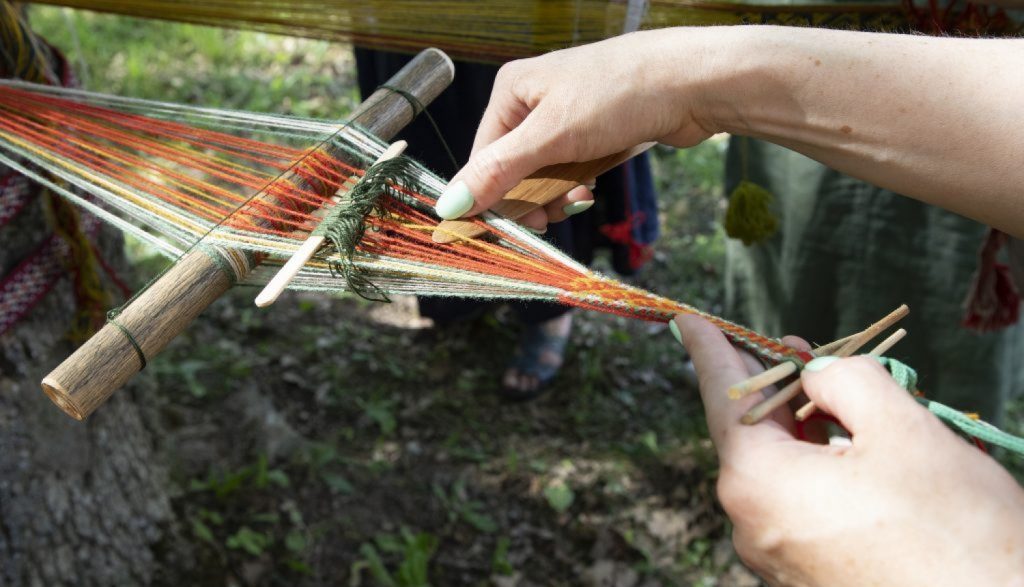
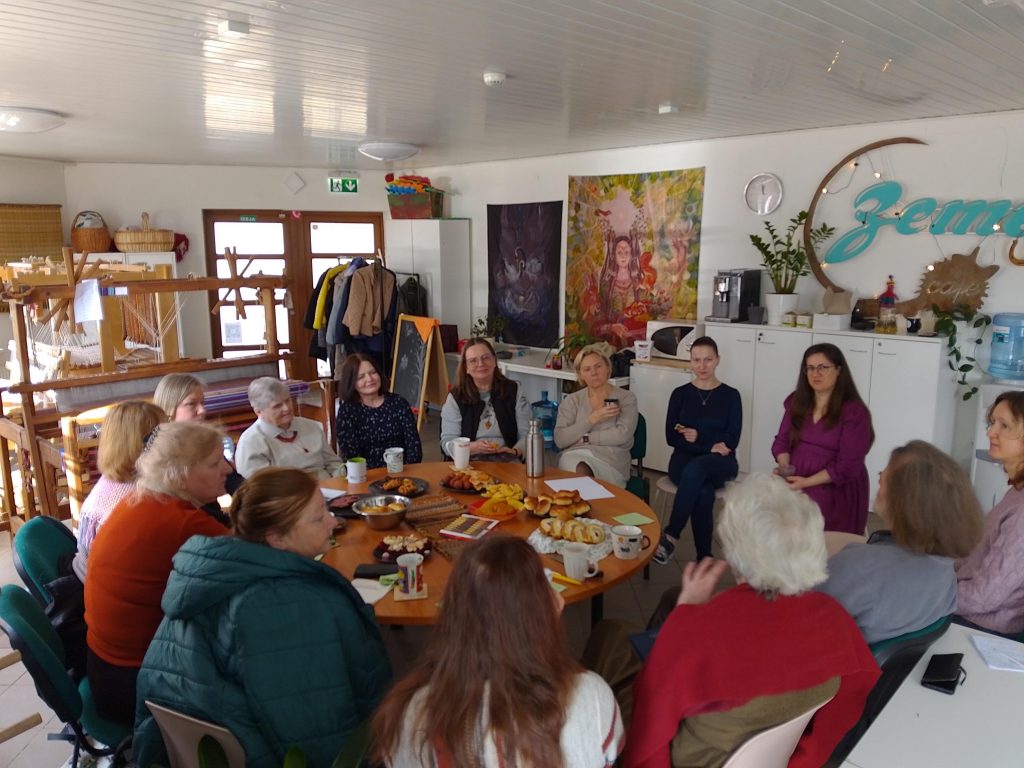
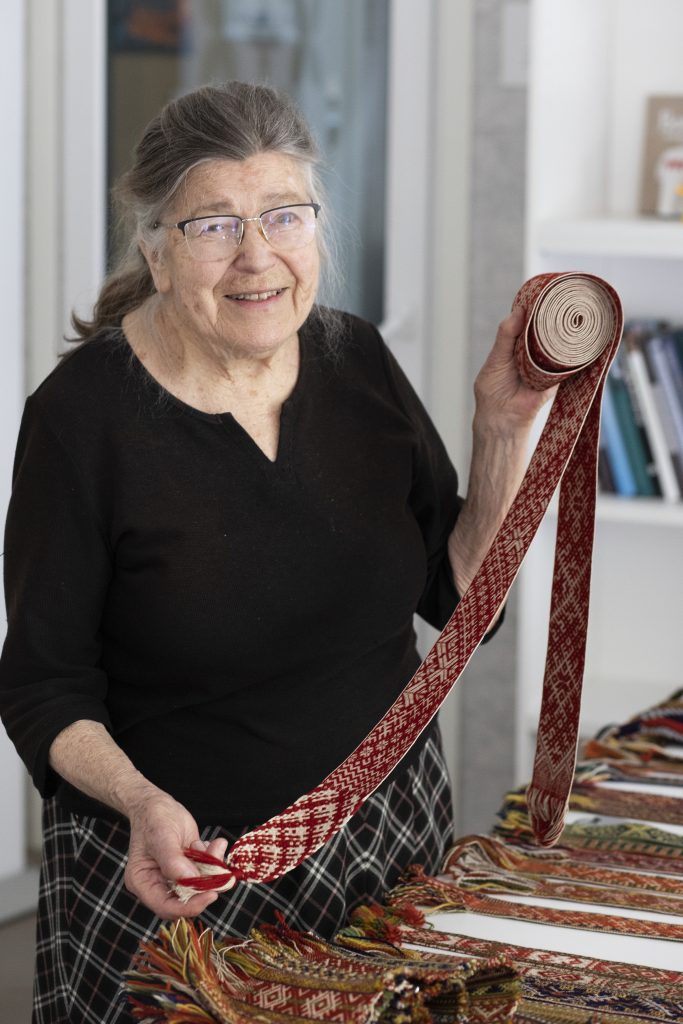

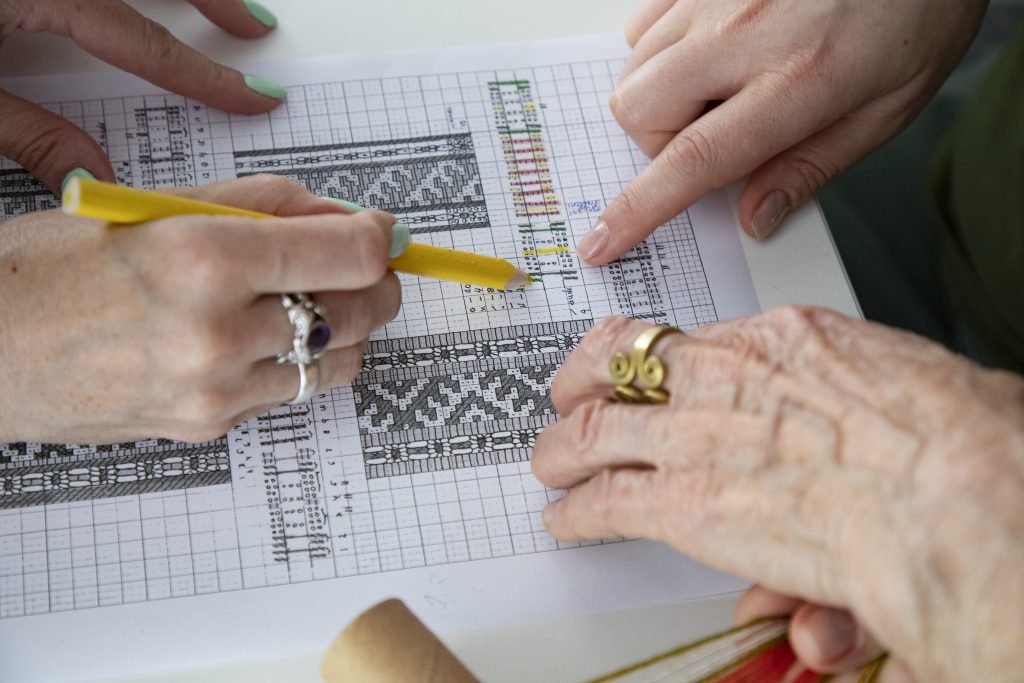
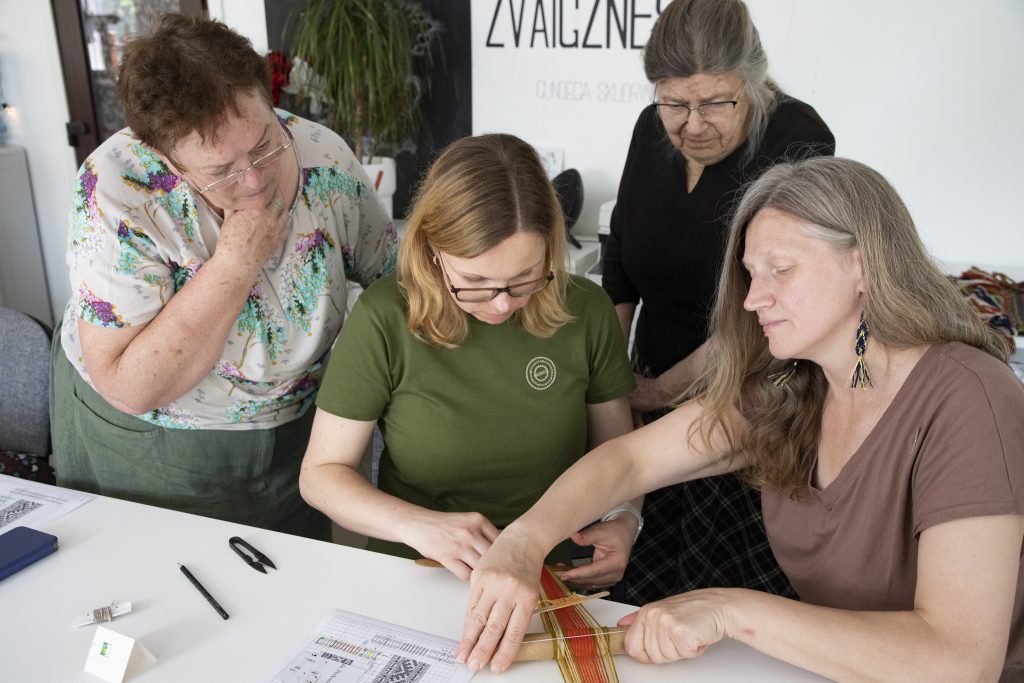
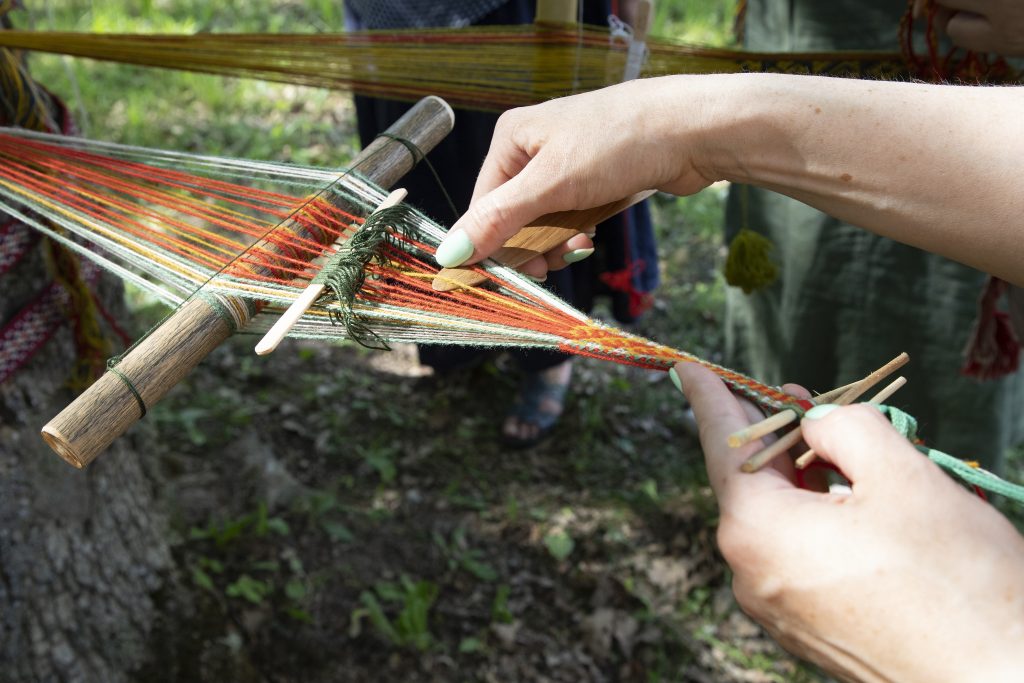
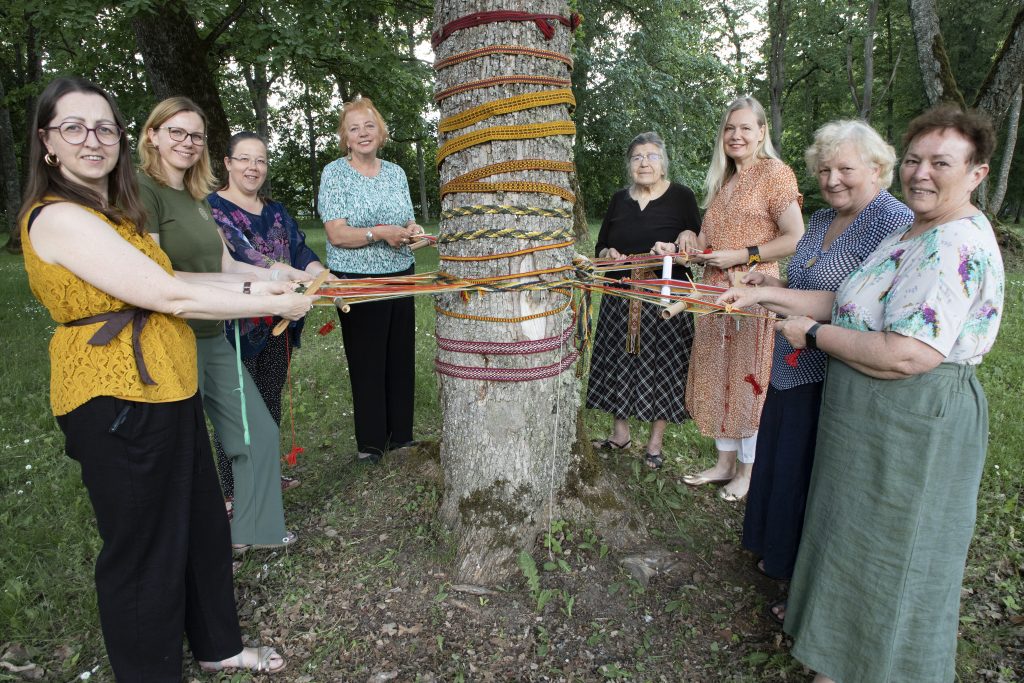
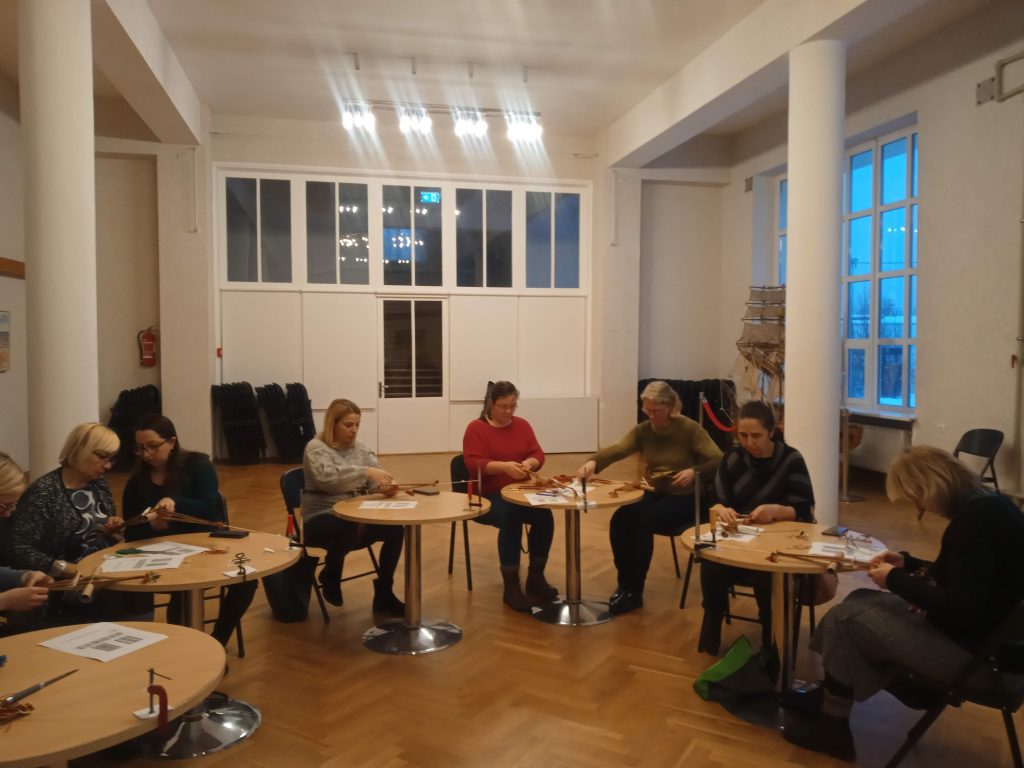
![{"capture_mode":"AutoModule","faces":[]}](https://nematerialakultura.lv/wp-content/uploads/IMG_20240302_170410_HDR-1-1024x768.jpg)
